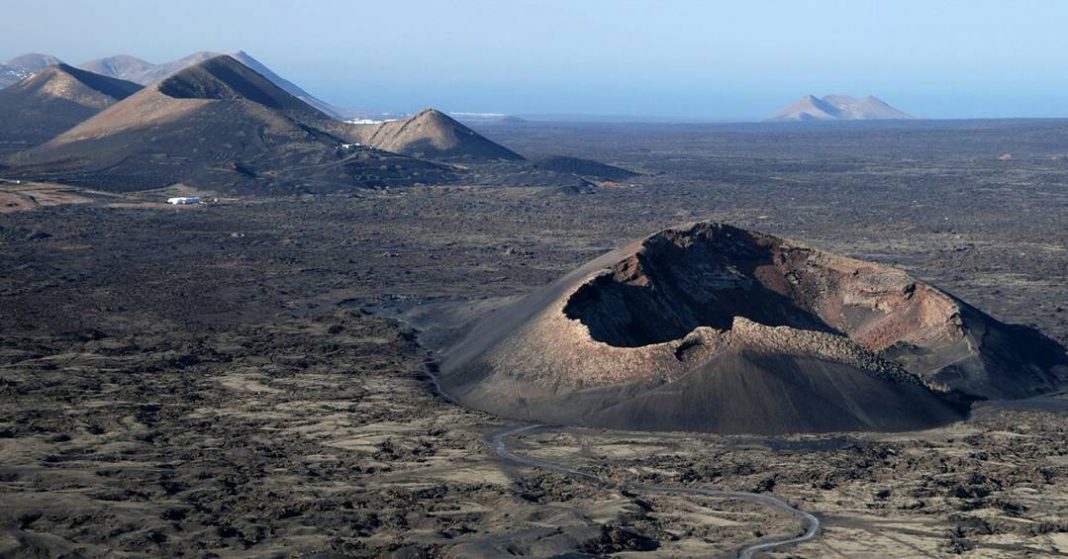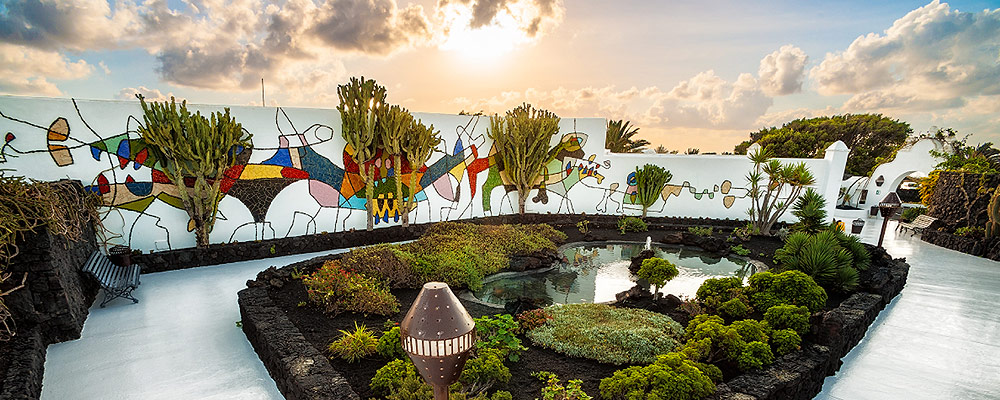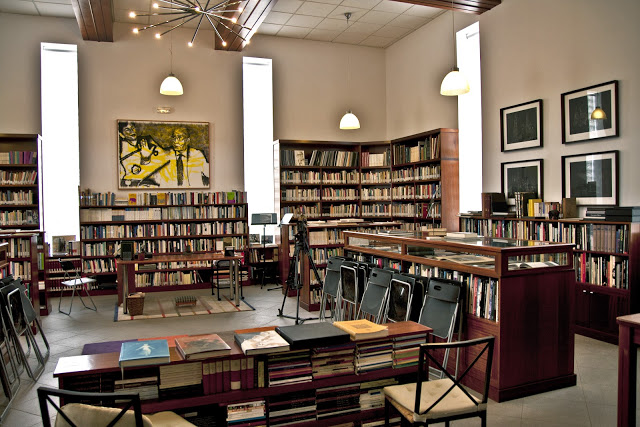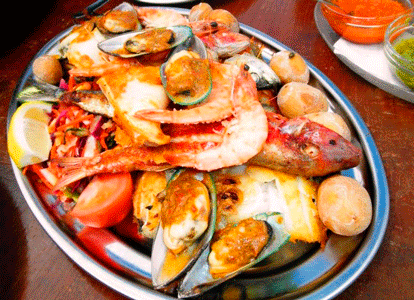La Isla más mágica del mundo

Lanzarote es una isla del Archipiélago Canario (España), en el Océano Atlántico. Forma parte de la provincia de Las Palmas. Su capital es Arrecife.
El nombre de la isla procede del marino genovés Lanceloto Malocello, quien la visitó en el siglo XIV. Con 152.289 habitantes (2019)1 Lanzarote es la tercera isla más poblada de Canarias, tras Tenerife y Gran Canaria. Con una superficie de 845,94 km² es la cuarta isla más extensa del archipiélago.
LANZAROTE no se puede entender sin el gran artista Cesar Manrique. A mediados de los sesenta fijó su residencia en la isla y desde entonces toda su vida fue Lanzarote y el Arte.
«Mi intención es convertir mi isla natal, Lanzarote, en uno de los lugares más hermosos del planeta». Desde ese momento y hasta su muerte en un accidente de coche en 1992, creó una serie de intervenciones artísticas que transformaron para siempre esta isla del archipiélago canario. Y, efectivamente, convirtió a Lanzarote en uno de los lugares más hermosos que se pueda disfrutar.

César Manrique (1919-1992)
César Manrique (1919-1992) nació en Arrecife, Lanzarote, isla en la que su trayectoria artística ha dejado huellas imborrables.
En 1964, se traslada a vivir a Nueva York, donde expuso individualmente en tres ocasiones en la galería Catherine Viviano.
A mediados de los años sesenta, coincidiendo con su traslado de residencia a Lanzarote, César Manrique impulsa en la Isla una serie de proyectos artísticos de carácter espacial y paisajístico, novedosos para la época, donde plasma su pensamiento plástico y ético.
Así, elaboró un nuevo ideario estético, que denominó arte-naturaleza/ naturaleza-arte, en el que integra distintas manifestaciones artísticas, que pudo concretar en sus obras paisajísticas, un ejemplo singular de arte público en España: Jameos del Agua, Mirador del Río, Jardín de Cactus, Timanfaya, etc.
Fundación César Manrique. Taro de Tahíche.

La Fundación César Manrique (FCM) fue constituida por César Manrique en el año 1983, y puesta en marcha en 1992.Tiene su sede en la antigua vivienda del artista en Taro de Tahíche, Lanzarote. La FCM es una institución cultural privada, sin ánimo de lucro, que fundamenta su actividad a través de cuatro áreas complementarias de trabajo: César Manrique, las artes plásticas, el medio ambiente y el territorio, y la reflexión cultural.
Casa-Museo César Manrique. Haría

La Casa-Museo César Manrique está situada en medio de un extrardinario palmeral en el pueblo de Haría.
A comienzos de 1986, Manrique inició las obras de construcción de su nueva casa reutilizando y adaptando una vivienda de labranza, en ruinas, ubicada en una finca agrícola que había adquirido en los años setenta. Aquí vivió hasta 1992, el año de su muerte. En 2013 se abrió al público como Casa-Museo. Su recorrido permite al visitante contemplar las estancias de la residencia y el taller en los que el pintor trabajó y pasó los años finales de su vidaos objeti
Parque Nacional de Timanfaya

Fue declarado Parque Nacional el 9 de agosto de 1974.
Ocupa una extensión de 51,07 km² del suroeste de la isla. Se trata de un parque de origen volcánico. Las últimas erupciones se produjeron en 1824. Cuenta con más de 25 volcanes, siendo algunos emblemáticos, tales como las Montañas del Fuego, Montaña Rajada o la Caldera del Corazoncillo. Aún presenta actividad volcánica, existiendo puntos de calor en la superficie que alcanzan los 100-120 C y 600 C a 13 metros de profundidad.
La erupción de Timanfaya
“El día 1 de septiembre de 1730 , entre las nueve y las diez de la noche, la tierra se abrió en Timanfaya, a dos leguas de Yaiza… y una enorme montaña se levantó del seno de la tierra«,4 según el testimonio del párroco Lorenzo Curbelo. La isla se transformó por completo. Nueve pueblos quedaron enterrados y durante seis años la lava se extendió por la zona sur cubriendo un cuarto de la isla y llenando las vegas cercanas de cenizas volcánicas. En 1824 de nuevo comienzan las erupciones en Timanfaya, dando origen a los llamados Volcán de Tinguatón, Tao y del Fuego. Se produjeron terribles hambrunas y buena parte de la población se vio obligada a emigrar.
En la actualidad, con 1 655 772 visitantes anuales (2020), Timanfaya es el segundo parque nacional en número de visitas de Canarias, tras el parque nacional del Teide en Tenerife.
Cueva de los Verdes

El túnel formado por el Volcán de la Corona es uno de los más extensos e interesantes del planeta. A lo largo de su recorrido existen al menos dieciséis Jameos. Los más de seis kilómetros de galería, se prolongan desde el cráter del volcán, hasta que se adentra en el mar en un tramo submarino de un kilómetro y medio, denominado «Túnel de la Atlántida». Visitar la Cueva de los Verdes le permitirá adentrarse y descubrir parte de este increíble túnel.
Jameos del Agua

Los Jameos del Agua, al igual que la Cueva de los Verdes, se localizan en el interior de un túnel volcánico producido por las erupciones del Volcán de la Corona. Los Jameos se localizan en la sección del túnel más cercano a la costa. Deben su nombre a la existencia de un lago interior originado por filtraciones marinas.
Jardín de Cactus

El Jardín de Cactus de Lanzarote acoge alrededor de 4.500 ejemplares de 450 especies diferentes agrupadas en 13 familias de cactus llegados desde los cinco continentes. Fue una de las últimas intervenciones arquitectónicas que realizó Cesar Manrique en la isla.
Mirador del Rio

El Mirador del Río está situado en el cabo norte de la isla, a 479 metros de altura sobre el nivel del mar y orientado hacia el noroeste, ofrece una vista privilegiada de la zona que comprende el archipiélago Chinijo (islas de la Graciosa, Montaña Clara, Alegranza, Roque del Este y Roque del Oeste).
El responsable de la reconstrucción de esta antigua posición de artillería, «Baterías del Río», fue el artista César Manrique, que mandó hacer una excavación en el monte, construyendo en la hondonada un restaurante, y puso dos cúpulas en ese gran espacio, sobre las que se echó tierra creciendo después la hierba sobre ellas.
A Casa Museo José Saramago, Tías.

José de Sousa Saramago (Azinhaga, 16 de noviembre de 1922–Tías, 18 de junio de 2010). La novela El Evangelio según Jesucristo (1991) lo catapultó a la fama a causa de una polémica sin precedentes en Portugal —que se considera una república laica—, cuando el gobierno vetó su presentación al Premio Literario Europeo de ese año, alegando que «ofendía a los católicos».
Como acto de protesta, Saramago abandonó Portugal y se instaló en la isla canaria de Lanzarote. En 1995 publicó una de sus novelas más conocidas, Ensayo sobre la ceguera. En 1997 publicó Todos los nombres, que gozó también de gran reconocimiento.
En 1998 ganó el Premio Nobel de Literatura, convirtiéndose en el primer escritor —y hasta ahora el único— de lengua portuguesa en ganar este premio. Desde entonces, compartió su residencia entre Lisboa y la isla canaria, participando en la vida social y cultural de ambos países, cuyas estrechas relaciones justificó en una entrevista para proponer su idea utópica de creación de una Iberia unida.4
Tanto su casa como la biblioteca privada se encuentran abiertas al público todo el año en el pueblo de Tías.
Falleció a los ochenta y siete años de edad, el día 18 de junio de 2010, en su residencia de la localidad de Tías (Lanzarote), a causa de una leucemia crónica que derivó en un fallo multiorgánico.
Salinas de Janubio, Yaiza.

Salinas de Janubio es una de las estampas paisajísticas más impresionantes de Lanzarote. Su incalculable valor natural y cultural se ve engrandecido por su entorno. Rodeadas de los últimos coletazos volcánicos de Timanfaya, una laguna natural imprescindible en el proceso de elaboración de la sal y la mística playa de arena negra de Janubio. Operativa desde 1895, en su etapa más dorada salían 13 millones de kilos de sal al año. A día de hoy las salinas están al 15% de rendimiento. Alrededor de 2,5 millones de kilos de sal se extraen anualmente.
El Golfo, Yaiza.

El Golfo es un anfiteatro abierto al océano que se formó a raíz de las erupciones de 1730. La laguna que ocupa el fondo del semicírculo surgió debido a la inundación del cráter. Su color verde se debe a las algas que habitan en su superficie.
El mar pasa por medio del cráter formando una hermosa playa negra que contrasta con el verde del Lago, comunicándose con éste por medio subterráneo. Este lago ha sido declarado Reserva Natural, por lo que el baño está prohibido.
A pocos metros se halla el pueblo de El Golfo, donde podrá disfrutar de varios restaurantes frente al mar.
Haria, el valle de las mil Palmeras.

Los Pueblos más bonitos de Lanzarote:
Arrieta, Tinajo, San Bartolomé, Yaiza, Teguise, El Golfo, Femés, Haría, Tías.
Playa del Papagayo.

En el sur de la isla de Lanzarote, en un entorno virgen de extrema belleza y protegido al amparo del Parque Natural de los Ajaches, se encuentra la playa salvaje de Papagayo. Con vistas a la vecina isla de Lobos y a Fuerteventura , destaca su fina arena dorada y la calidad de sus aguas, tan trasparentes que en ocasiones adquieren un color esmeralda intenso.
La Geria.

La Geria constituye uno de los paisajes agrarios más característicos de la isla de Lanzarote. Considerado Espacio Natural Protegido, está formado principalmente por roca volcánica y su uso más característico son las plantaciones de viñas que aprovechan para su desarrollo las posibilidades de lapilli como retenedor de la humedad.
El Vino en Lanzarote.

El cultivo de la vid en Lanzarote es único en el mundo, conserva las características primigenias de un procedimiento que permite, que de una tierra yerma y calcinada, nazca un vino generoso y refinado, hijo de la lava, fuerte como el volcán, mimado bajo cenizas encargadas de atesorar cada gota de rocío, tan valiosa en una tierra sin manantiales.
En la Geria hay muchas Bodegas históricas, como El Grifo, Los Bermejos, La Geria, Vega de Yuco y otras.
La Bodega el Grifo es la más antigua de Canarias y está entre las diez más antiguas de España. Elabora vinos ininterrumpidamente desde 1775.
El malvasía de Lanzarote uno de los mejores vinos del mundo. La Malvasía es una de las cepas más antiguas que se conocen. Es originaria de Asia Menor y debe su nombre al puerto de Monemvasía, localizado en el sur del Peloponeso, desde donde se comercializó primero.
En el siglo XIX la filoxera arrasó buena parte de las viñas del sur de Europa, Francia, España, Italia. En Lanzarote la plaga de filoxera no llegó entre otras cosas por la lejanía con el continente europeo y por la insularidad, lo cual permitió que se mantuvieran plantas de pie franco, lo que le aporta una característica especial a los caldos
Gastronomía.

El Gofio ha sido históricamente el alimento canario más importante. Consumido en toda Canarias desde la época aborigen, forma parte de la identidad canaria. El Gofio es harina de cereal tostado, que puede consumirse en cualquier comida y acompañado de leche, miel, azúcar o vino, acompañando a un caldo de pescado…Jareas, lapas, atún en adobo, queso… son algunos ejemplos de estos platos que aún podemos encontrar en bares y restaurantes. Un plato típico son los pejines, sardinas pequeñas o boquerones que se dejan secar al sol y se comen tal cual. Las papas arrugadas son quizá uno de los platos más populares. Un mojo es el acompañante perfecto para las papas arrugadas o un plato de la mar. Ya sea rojo o picón, hecho con pimientos picones canarios, o verde, a base de cilantro, cubre los pescados o se mojan en él las papas.
Las sardinas asadas se combinan bien con unas papas arrugadas mojadas en mojo. Preparadas con abundante sal, forman parte de la estampa típica del asadero de Lanzarote, en la que se prueba el vino y el timple interpreta el folklore de la Isla.
Los platos, con muy importante presencia del mar, como el caldo de pescado, el sancocho, el pescado encebollado…El sancocho es uno de los platos más importantes de Canarias. Se elabora con cherne, papas, batatas…, y suele ir acompañado de mojos y gofio. La vieja, un pez con boca en forma de pico de loro, presentando colores muy variados, predominando el gris y el rojo. Es muy sabrosa guisada o a la espalda – abierta por el lomo ya la plancha. Las jareas, pescados abiertos por el lomo que luego se salan; los pejines, pescados pequeños y salados; y los tollos, tiras de cazón o de otros escualos, seca y endurecida por el sol y el aire.
La ganadería también está presente, y el rancho canario o la carne de cabrito o conejos en salsa muestran la maestría que se ha alcanzado en su preparación
Comer en Lanzarote

